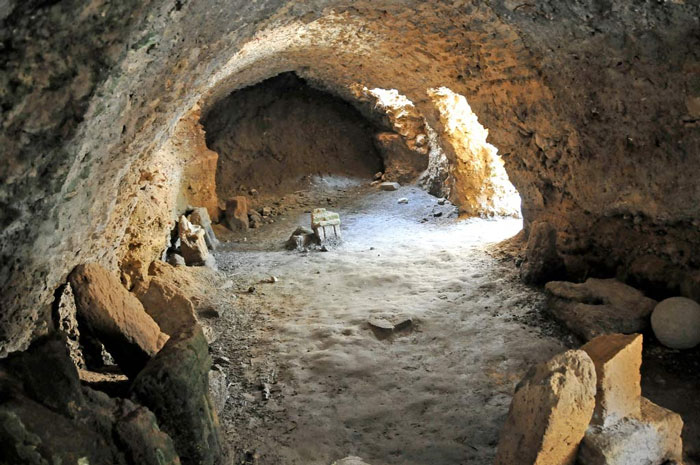New explanation for the mass sacrifice of children
The site of the remains of thousands of children in Carthage (Tunisia) may not be a place of child sacrifice, but a resting place for babies and unfortunate babies who die early, medium scientists said.
New research on ancient sites in North America provides a new explanation for the true purpose of a young children's graveyard that has long been believed to be sacrificed.
The city of Carthage was built in the 9th century BC, when Queen Dido left Phoenicia (on the east coast of the Mediterranean) to the area of present-day Tunis of Tunisia. This empire became the center of power of the ancient world and once fought several battles against the mighty Roman army.
Archaeologists began excavating ancient texts from a century ago, and they found cremation vessels of thousands of babies, goats and sheep in the graveyard called Tophet - the place used used in the period from 700-300 million VND. At its peak, Tophet grew larger than a football field and had nine burial floors.
Based on historical information, scientists believe that the Carthaginians sacrifice children at Tophet before burying them there. The Bible describes the sacrifice of children to the Baal god, worshiped in Carthage civilization. A Greek historian and a Roman historian recounted stories from this period in which priests cut babies' throats and threw them into a fire pit, Jeffrey Schwartz of Pittsburgh University (USA). said.
However, such information comes from the Carthaginian enemy.'Some information in it may have been launched against the Carthaginians ,' Schwartz said.

Tophet is hosting the remains of thousands of children.(Source:Livescience)
In 2010, Schwartz and colleagues based the remaining pieces of 540 babies to argue that this place was not a place to kill children for sacrifice. The new explanation has just been published in the issue of Antiquities magazine this month.
In the recently published article, researchers cite many ancient studies to confirm that the method of estimating the age of children based on teeth is reliable.
The team thinks that many pieces of teeth found in Tophet are actually part of the teeth that have not been raised from the benefits of fetuses or babies who have just died prematurely, so they cannot be said to be life sacrifice. Evidence shows that half of all teeth show that babies die in less than a month. The pressure during childbirth temporarily stops the infant's teeth from developing, creating a tiny black line on the gum. However, this black line only forms after 1 or 2 weeks after the baby is born.
However, some other researchers still believe that Tophet is the place where children live.

'The different ages of children here show that the Carthaginians sacrifice 1-month-old babies,' said Patricia Smith, an anthropologist at Jeruralem Jewish University.
Smith's group published an article in 2011 to question Schwartz's method of analyzing tooth samples. High temperatures and pressures during cremation can remove the child's tracks less than a month, so it is not possible to confirm that this is the correct method of age determination. Schwart's group miscalculated the extent of the teeth falling during the cremation, leading to an estimate of the wrong age, Smith argued.
Smith also disagreed that the Carthaginians had a habit of cremating newborns prematurely. At that time, the rate of infant deaths was extremely high, so children were only considered people until they were 1 or 2 years old. The Carthaginians cut down most of the trees to plant crops, and will not use precious firewood for young cremation.
'The Carthaginians are very good at the sea; they need wood to build boats and other tools, " Smith said.
- Terrible mass grave of 227 sacrificed children
- Scary secrets in mass graves buried hundreds of children
- Doubts surrounding an 800-year-old mass grave in Peru
- Bacteria know how to cooperate and sacrifice for their kind
- Horror of the 140-year-old collective sacrifice ceremony 500 years ago
- Children with normal BMI are still obese
- Decipher mysteriously 42 children's bones buried with llamas in Peru
- Sacrifice strange people in Syria
- Inside the Mayan goddess cave
- Tragedy after the mass grave in British university
- The mass of the Milky Way
- Rising vegetable prices increase obesity
 The truth about the mysterious red-haired giant at Lovelock Cave
The truth about the mysterious red-haired giant at Lovelock Cave Inunaki Tunnel: The haunted road leading into Japan's 'village of death'
Inunaki Tunnel: The haunted road leading into Japan's 'village of death' The mystery of the phenomenon of human reflection before dying
The mystery of the phenomenon of human reflection before dying 6 mysterious phenomena, although science has been developed for a long time, still cannot be answered
6 mysterious phenomena, although science has been developed for a long time, still cannot be answered